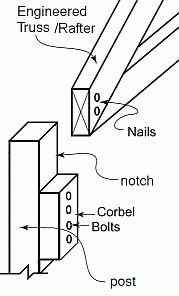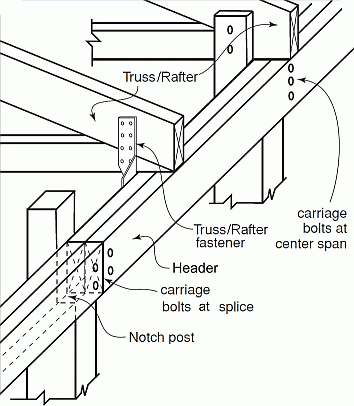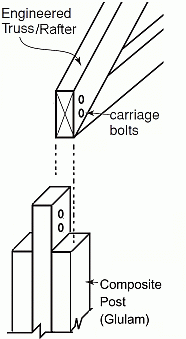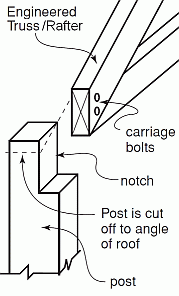Depending on what part of the country you live in the method of attaching the trusses (or rafters) to the posts will be different. This comes from several different reasons, including the ability to resist snow loads, wind loads, and earthquake loads, to just plain old construction methods used in your neck of the woods.
Trusses/Rafters Rest on Corbel  The method most widely used in the northwestern part of the United States is the direct attachment of trusses to the structural posts. The method most widely used in the northwestern part of the United States is the direct attachment of trusses to the structural posts.This is also one of the easiest methods of constructing a pole barn. In this method, the trusses (or rafters) are attached to the structural posts with nails. The trusses rest on wooden blocks called corbels. These wooden corbels are bolted into the post so that the weight from the trusses are transfered directly into the posts. (See drawing at right.) |
Trusses/Rafters Attached To a HeaderMany times in the southeastern part of the United States, you will see a header attached to the structural posts. The trusses (or rafters) are then placed on, and rest on, this header board and are attached by fasteners. (See drawing below.)  |
Trusses/Rafters Rest on Glulam Posts  Glue Laminated columns (posts), also called GluLams, are becoming more affordable to manufacturer and provide stronger resistance to wind and snow loads. In some parts of the country, glulam posts are even more economical to buy than solid posts. These glulam structural posts can be manufactured to accept trusses or rafters at the top of the post. The trusses or rafters are placed on the sides (or sometimes the middle) of the glulam post. (See picture at right). The trusses are then bolted or nailed to the glulam structural post. |
Trusses/Rafters Rest on a Notched Post  Another method employed by some contractors is to notch the structural post at the top and place the trusses (or rafters) on top of the notch. (See photo at right.) Another method employed by some contractors is to notch the structural post at the top and place the trusses (or rafters) on top of the notch. (See photo at right.)The truss/rafter is then fastened to the post with nails or bolts. Notching posts needs to be done by a seasoned professional, however. If the notch is not done appropriately then the post can begin to split. This method is commonly used on pole barns that use round posts (often called telephone poles). The notch allows the truss to not only rest on the pole but to also seat properly against to the pole to provide a well formed connection. |




